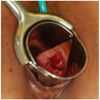Abstract
Transobturator tape (TOT) as one of midurethral slings is increasingly popular for the surgical treatment of stress urinary incontinence because of low complication rate and short operating time. Vaginal erosion after TOT is generally observed in 0.7%-1.3% of all cases. For preventing complications like vaginal erosion or infection after TOT, subtotal or total excision of mesh materials and use of broad-spectrum antibiotics are recommended. We report our experience with a case of treatment using skin flap and foreign body removal of recurrent mesh erosion in TOT.
Figures and Tables
Fig. 2
Skin Flap operation using rotation flap around the disrupted operation wound after second operation 5 days.

References
1. Kim MH, Lee CM, Jeong HH, Noh JG, Kim YB, Kim JW, et al. Questionnaire-based study on the prevalence and scope of urinary incontinence in Korean women. Korean J Urogynecol. 2000. 2:75–85.
2. Song HJ, Lee DH, Lee JY, Kim MJ. Epidemiologic study of urinary incontinence for Korean women over 30 years old. J Korean Continence Soc. 2001. 5:24–38.
3. DeSouza R, Shapiro A, Westney OL. Adductor brevis myositis following transobturator tape procedure: a case report and review of the literature. Int Urogynecol J Pelvic Floor Dysfunct. 2007. 18:817–820.
4. But I. Vaginal wall erosion after transobturator tape procedure. Int Urogynecol J Pelvic Floor Dysfunct. 2005. 16:506–508.
5. Abrams P, Artibani W. Understanding stress urinary incontinence. 2004. Lier (BE): Ismar Healthcare.
6. Moller LA, Lose G, Jorgensen T. The prevalence and bothersomeness of lower urinary tract symptoms in women 40-60 years of age. Acta Obstet Gynecol Scand. 2000. 79:298–305.
7. Petros PE, Ulmsten UI. An integral theory of female urinary incontinence. Experimental and clinical considerations. Acta Obstet Gynecol Scand Suppl. 1990. 153:7–31.
8. Delorme E. Transobturator urethral suspension: mini-invasive procedure in the treatment of stress urinary incontinence in women. Prog Urol. 2001. 11:1306–1313.
9. Nilsson CG, Kuuva N, Falconer C, Rezapour M, Ulmsten U. Long-term results of the tension-free vaginal tape (TVT) procedure for surgical treatment of female stress urinary incontinence. Int Urogynecol J Pelvic Floor Dysfunct. 2001. 12:Suppl 2. S5–S8.
10. Nilsson CG, Falconer C, Rezapour M. Seven-year follow-up of the tension-free vaginal tape procedure for treatment of urinary incontinence. Obstet Gynecol. 2004. 104:1259–1262.
11. Abouassaly R, Steinberg JR, Lemieux M, Marois C, Gilchrist LI, Bourque JL, et al. Complications of tension-free vaginal tape surgery: a multi-institutional review. BJU Int. 2004. 94:110–113.
12. Fischer A, Fink T, Zachmann S, Eickenbusch U. Comparison of retropubic and outside-in transoburator sling systems for the cure of female genuine stress urinary incontinence. Eur Urol. 2005. 48:799–804.
13. Sohn DW, Bae WJ, Lee HJ, Jung JU, Kim SW, Lee NS, et al. Infective cellulitis of obturator foramen and persistent vaginal erosion following transobturator tape (tot) procedure. J Korean Continence Soc. 2008. 12:78–80.
14. Benassi G, Marconi L, Accorsi F, Angeloni M, Benassi L. Abscess formation at the ischiorectal fossa 7 months after the application of a synthetic transobturator sling for stress urinary incontinence in a type II diabetic woman. Int Urogynecol J Pelvic Floor Dysfunct. 2007. 18:697–699.




 PDF
PDF ePub
ePub Citation
Citation Print
Print





 XML Download
XML Download